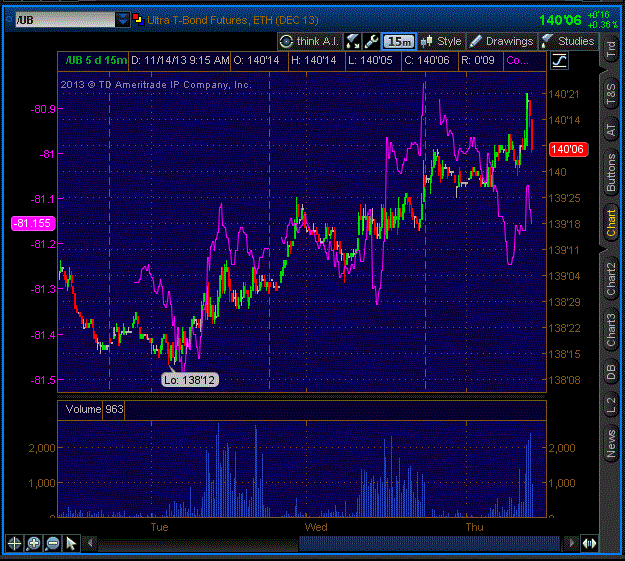Today’s AM fix was USD 1,283.25, EUR 955.23 and GBP 801.53 per ounce.
Yesterday’s AM fix was USD 1,276.00, EUR 951.25 and GBP 798.75 per ounce.
Gold rose $4.40 or 0.35% yesterday, closing at $1,273.30/oz. Silver slipped $0.19 or 0.92% closing at $20.56. Platinum fell $5.55 or 0.4% to $1,424.20/oz, while palladium fell $9.50 or 1.3% to $727.97/oz.
Gold inched up again after Federal Reserve Chairman nominee Janet Yellen said the U.S. economy and labor market must improve before QE is reduced. This lifted confidence as silver prices recovered from their lowest levels since August. “The focus for the bullion market may shift to the upcoming testimony by Yellen,” James Steel, an analyst at HSBC, commented. “Chinese gold demand remains brisk. However, gold is likely to remain on the defensive in the near term”, wrote Steel.
The latest long term gold trend research from Nick Laird at ShareLynx indicates that the price of gold may rise in the near future. In the chart below, Nick references those periods from the past when it was prudent to buy and to sell. He also indicates that this particular period, November 2013, may be a prudent time to to buy. This chart reaffirms GoldCore’s long term outlook for the price of gold.

Long Term Gold Trend (www.sharelynx.com)
“Sometimes it’s not enough to know what things mean, sometimes you have to know what things don’t mean.” Bob Dylan
The Bank of England says the UK recovery has taken hold and Chancellor George Osborne is reported as saying “the report was proof the government’s economic plan was working.” The governor of the Bank of England, Mark Carney, said the bank will not ‘consider’ raising interest rates until the jobless figure falls below 7%.
However, The Bank of England threw a get-out-of-jail card on the table and said that there was a two-in-five chance of the unemployment rate reaching the 7% threshold by the end of 2014. And then added that the corresponding figures for the end of 2015 and 2016 are around three in five and two in three respectively. What exactly does the Bank of England mean or what does this not mean?
The financial crisis of 2007-2008 has sparked the most intense interest in international monetary reform since Richard Nixon closed the gold window at the New York Fed and devalued the U.S. dollar in 1971. Nixon’s action was widely seen at the time as presaging the end of the dollar-based world trade and financial system. On the face of it, this probably wasn’t an unreasonable expectation at the time. Within fewer than ten years, however, it was proven to be far off the mark. The dollar fell alright, but by the middle 1980s had recovered strongly.
In retrospect it is clear why the dollar sceptics were wrong. To begin with, the U.S. economy was still the world’s largest and the U.S. was still the leader of the “free world,” that is to say the world outside the communist bloc. The NATO countries of Western Europe were wholly dependent on the U.S. for security as well as for markets.
The same applied to Japan, South Korea and Taiwan, while the signatories of the secret UK/USA intelligence agreement (the U.S., UK, Canada, Australia and New Zealand) represented the Anglo core of the old British Empire, a group with no interest in seeing the dollar replaced. Communist Russia and China were in no position to register an opinion, much less offer an alternative. By default, the dollar soldiered on, thanks to the geopolitical realities of the time.
But what about today’s realities? Continue this fascinating story in our November edition of Insight – Talking real money: World Monetary Reform.
Click here to download your own copy of Talking real money: World Monetary Reform
Click Gold News For This Week’s Breaking Gold And Silver News
Click Gold and Silver Commentary For This Week’s Leading Gold And Silver Comment And Opinion
Like Our Facebook Page For Breaking News, Interesting Insights, Blogs, Prizes and Special Offers







via Zero Hedge http://feedproxy.google.com/~r/zerohedge/feed/~3/nkU5IH8gGv0/story01.htm GoldCore
![]()














